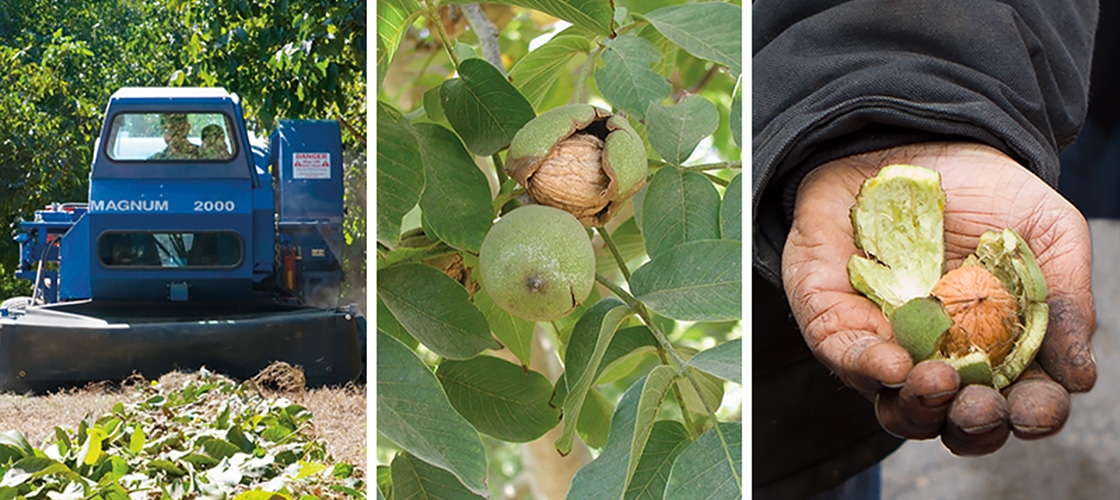David B. Neale, Dept. of Plant Sciences, UC Davis
The Walnut Improvement Program (WIP) at UC Davis has had a long history of successful breeding, variety development and release. Throughout its history the WIP has used classical breeding methods which entails making large numbers of crosses annually and then evaluating offspring for these crosses for a period of many years. As successful as the WIP has been, it takes many years to breed, test and release new varieties and has a high demand for labor and land.
Beginning as far back as the 1980s, many agricultural crops and livestock species began using molecular marker technologies to increase speed and efficiency of breeding. Most of the major cereal and vegetable crops are now bred with some input from molecular markers. The horticulture and forestry crops have been much slower to adopt molecular breeding technologies, although the time savings with perennial crops is potentially much greater than with annual crops.
The California Walnut Board (CWB) has for many years recognized the need and opportunity to modernize the WIP by implementing molecular breeding. To that end, it has supported molecular genetic research of Professors McGranahan, Dandekar and Dvorak for several years. Funding provided to these research labs initiated the development of a variety of molecular genetic technologies that would be needed to ultimately implement molecular breeding in the WIP.
In late 2013, the CWB recognized that a bigger commitment to developing molecular breeding was needed and I was approached about joining the effort. Prior to that, I had been involved in developing molecular breeding for the US Forest Industry for 25 years. A 5-year strategic research plan was developed that would deliver fully implemented molecular breeding upon project completion. The CWB agreed to fund the project at a level where it could be successful. The project began in 2014 and will be completed by the end of 2018.
The strategic research plan has a series of annual goals that follow a sequence of major research tasks to accomplish the ultimate goal – implementing molecular breeding in the WIP. The goal for year 1 (2014) was to sequence the walnut genome. The DNA sequence of the genome and all the genes is a necessary resource for any molecular breeding program and had not yet been done for English Walnut. Logically, Chandler was chosen as the variety to be sequenced and that task was completed in early 2015. The genome sequencing project was done in collaboration with Professor Charles Langley in the Dept. of Evolution and Ecology, Professor Dandekar, Professor Steven Salzberg at Johns Hopkins University, and Professor Jill Wegrzyn at the University of Connecticut. Now a modern “parts list” was available for all walnut researchers. The goal for year 2 (2015) was to discover and characterize the genetic variation in the WIP by sequencing all the founding individual trees that have been used to establish the program. This required sequencing the genomes of 29 more trees. This was made technically possible and affordable because of the high quality reference genome sequence for Chandler. This task was completed in early 2016. In that same year, although outside the original strategic plan, five additional Juglans genomes were sequenced (nigra, microcarpa, hindsii, sigillata and cathayensis), to provide these important resources to researchers in the SCRI rootstock improvement research project. Also in year 3, a research project was initiated to understand the molecular basis of water use efficiency in walnuts toward using molecular breeding technologies for drought-hardy varieties. This work was led by MS student Randi Famula in collaboration with Professor Jim Richards from the Dept. of Land, Air and Water Resources. Famula’s thesis is completed and she will graduate in June 2017.
The goal for year 3 (2016) was to develop a modern and high throughput method for genotyping 1000s of trees in the WIP. Postdoc Pedro Martinez-Garcia and Bioinformatician Kristian Stevens began the design of this modern method which was completed in collaboration with Drs. Michela Troggio and Luca Bianco at the Edmund Mach Foundation in Trento, Italy. Affymetrix Inc. built the genotyping system which was used to genotype 1000+ trees from the WIP. This task was completed in late 2016. Also in 2016, a new project was initiated by PhD student Gina Sideli, to develop new technologies to measure seal strength in walnut shells and kernel color.
The goal for year 4 (2017) is to bring the genotype data and WIP trait data together into a genetic analysis to identify molecular markers associated with the traits routinely measured in the WIP by Chuck Leslie which includes a suite of 28 yield, nut, phenology and tree architecture traits. These analyses are being done by postdoc Annarita Marrano. Before the trait data can be used, quantitative genetic analysis of the trait data must be performed and this is being done in collaboration with Professor Tom Famula of the Dept. of Animal Sciences.
Finally, the goal for year 5 (2018) will be to develop statistical models and computer software to be used in molecular breeding in the WIP. Marrano and Sideli will work with Professor Famula and Chuck Leslie to complete this task. In addition, we also hope to work with the new walnut breeder Professor Patrick Brown, in the model development. At the end of 2018 I will have completed all the goals of the 5-year plan and the molecular breeding in the WIP will proceed under the direction of Professor Brown.

